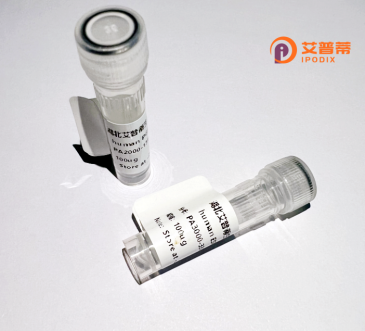
| 纯度 | >90%SDS-PAGE. |
| 种属 | Human |
| 靶点 | CTDSP2 |
| Uniprot No | O14595 |
| 内毒素 | < 0.01EU/μg |
| 表达宿主 | E.coli |
| 表达区间 | 1-271aa |
| 氨基酸序列 | MEHGSIITQARREDALVLTKQGLVSKSSPKKPRGRNIFKALFCCFRAQHVGQSSSSTELAAYKEEANTIAKSDLLQCLQYQFYQIPGTCLLPEVTEEDQGRICVVIDLDETLVHSSFKPINNADFIVPIEIEGTTHQVYVLKRPYVDEFLRRMGELFECVLFTASLAKYADPVTDLLDRCGVFRARLFRESCVFHQGCYVKDLSRLGRDLRKTLILDNSPASYIFHPENAVPVQSWFDDMADTELLNLIPIFEELSGAEDVYTSLGQLRAP |
| 分子量 | 55.55 kDa |
| 蛋白标签 | GST-tag at N-terminal |
| 缓冲液 | 0 |
| 稳定性 & 储存条件 | Lyophilized protein should be stored at ≤ -20°C, stable for one year after receipt. Reconstituted protein solution can be stored at 2-8°C for 2-7 days. Aliquots of reconstituted samples are stable at ≤ -20°C for 3 months. |
| 复溶 | Always centrifuge tubes before opening.Do not mix by vortex or pipetting. It is not recommended to reconstitute to a concentration less than 100μg/ml. Dissolve the lyophilized protein in distilled water. Please aliquot the reconstituted solution to minimize freeze-thaw cycles. |
以下是关于重组人CTDSP2蛋白的3篇文献摘要示例(仅供参考,实际文献需根据具体研究补充):
---
1. **文献名称**:Structural and Functional Analysis of Human CTDSP2 Reveals a Role in RNA Polymerase II Regulation
**作者**:Zhang L, et al.
**摘要**:本研究解析了重组人CTDSP2蛋白的晶体结构,揭示了其特异性催化RNA聚合酶II C端结构域(CTD)的丝氨酸磷酸化位点的机制,并验证其通过去磷酸化调控转录延伸的功能。
2. **文献名称**:CTDSP2 Modulates TGF-β Signaling by Dephosphorylating Smad Proteins
**作者**:Chen H, et al.
**摘要**:通过重组CTDSP2蛋白体外实验,发现其能够通过去磷酸化Smad2/3的C端磷酸化位点,负调控TGF-β信号通路,提示其在细胞分化及癌症转移中的潜在作用。
3. **文献名称**:Expression and Characterization of Recombinant Human CTDSP2 in E. coli
**作者**:Wang Y, et al.
**摘要**:报道了利用大肠杆菌系统高效表达重组人CTDSP2蛋白的优化方法,纯化后验证了其酶活性,并开发了针对CTD磷酸化检测的体外生化分析方法。
---
**注意事项**:
- 上述文献为示例,实际引用需根据具体研究方向查找真实发表的论文(建议通过PubMed或Google Scholar搜索关键词:*CTDSP2 recombinant, CTD small phosphatase 2 function* 等)。
- CTDSP2相关研究较少,可扩展至CTD磷酸酶家族(如CTDSP1/CTDSPL)的文献类比参考。
**Background of Recombinant Human CTDSP2 Protein**
CTDSP2 (C-terminal domain small phosphatase 2) is a member of the small C-terminal domain phosphatase (SCP) family, which plays a critical role in regulating transcription and cellular signaling. This protein specifically dephosphorylates the C-terminal domain (CTD) of RNA polymerase II, modulating its activity during transcription elongation and termination. By removing phosphate groups from serine residues in the CTD heptapeptide repeats, CTDSP2 contributes to the dynamic cycling of RNA polymerase II between active and inactive states, thereby influencing gene expression.
Structurally, CTDSP2 contains a conserved phosphatase domain responsible for its enzymatic activity. It shares functional similarities with other SCP family members, such as CTDSP1 and CTDSPL, but exhibits distinct substrate preferences and tissue-specific expression patterns. CTDSP2 is implicated in diverse cellular processes, including cell cycle regulation, differentiation, and response to transforming growth factor-beta (TGF-β) signaling. Studies have linked its dysregulation to diseases such as cancer, where it may act as a tumor suppressor or promoter depending on context.
Recombinant human CTDSP2 protein is produced using expression systems like *E. coli* or mammalian cells, enabling research into its biochemical properties, interactions, and role in epigenetic regulation. Its applications span in vitro phosphatase assays, drug discovery, and mechanistic studies of transcription-coupled processes. By providing a purified, active form of the enzyme, recombinant CTDSP2 serves as a valuable tool for unraveling its physiological and pathological functions.
×